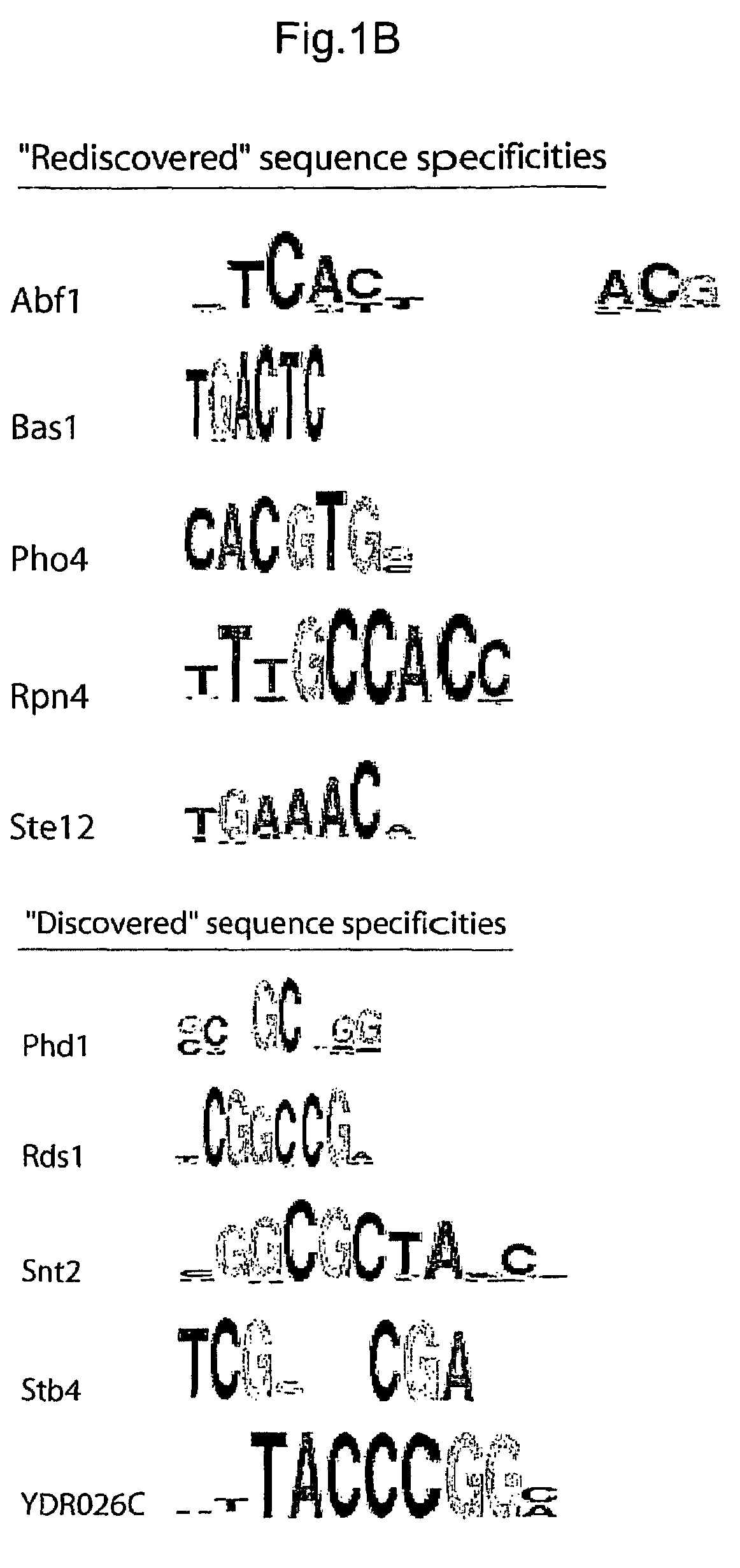Biologically-active DNA-binding sites and related methods
a dna binding site and biological technology, applied in the field of biologically active dna binding sites, can solve the problems of ill-defined dna sequences that actually contribute to the regulatory cod
- Summary
- Abstract
- Description
- Claims
- Application Information
AI Technical Summary
Benefits of technology
Problems solved by technology
Method used
Image
Examples
example 1
Identification of Biologically-Active DNA-Binding Sites
[0237]Applicants used genome-wide location analysis (Iyer et al. Nature 409, 533-8. (2001), Ren et al. Science 290, 2306-9. (2000), Lee et al. Science 298, 799-804. (2002), Lieb et al. Nat Genet 28, 327-34 (2001)) to determine the genomic occupancy of 203 DNA-binding transcriptional regulators in rich media conditions and, for 84 of these regulators, in at least one of twelve other environmental conditions (Table 1, FIG. 5, http: / / web.wi.mit.edu / young / regulatory_code). These 203 proteins are likely to include nearly all of the DNA-binding transcriptional regulators encoded in the yeast genome. Regulators were selected for profiling in an additional environment if they were essential for growth in that environment or if there was other evidence implicating them in regulation of gene expression in that environment. The genome-wide location data identified 11,000 unique interactions between regulators and promoter regions at high c...
example 2
Constructions of Transcriptional Regulatory Code
[0239]Applicants constructed an initial version of the transcriptional regulatory code by mapping on the yeast genome sequence the motifs that are bound by regulators at high confidence (P≦0.001) and that are conserved among sensu stricto Saccharomyces species (FIG. 2; http: / / web.wi.mit.edu / fraenkel / regulatory_map). This map includes 3,353 interactions within 1,296 promoter regions. Maps of regulatory sites encompassing larger numbers of promoters, constructed with lower confidence information, can also be viewed on the authors' website. Because the information used to construct the map includes binding data from multiple growth environments, the map describes transcriptional regulatory potential within the genome. During growth in any one environment, only subsets of the binding sites identified in the map are occupied by transcriptional regulators, as Applicants describe in more detail below.
[0240]Where the functions of specific tran...
example 3
Identification of Conditions which Alter the Distribution of Biologically-Active DNA-Binding Sites
[0244]By conducting genome-wide binding experiments for some regulators under multiple cell growth conditions, Applicants learned that regulator binding to a subset of the regulatory sequences is highly dependent on the environmental conditions of the cell (FIG. 8). Applicants observed four common patterns of regulator binding behavior (FIG. 4, Table 7). Prior information about the regulatory mechanisms employed by well-studied regulators in each of the four groups suggests hypotheses to account for the environment-dependent binding behavior of the other regulators.
[0245]“Condition invariant” regulators bind essentially the same set of promoters (within the limitations of noise) in two different growth environments (FIG. 4). Leu3, which is known to regulate genes involved in amino acid biosynthesis, is among the best studied of the regulators in this group. Binding of Leu3 in vivo has b...
PUM
| Property | Measurement | Unit |
|---|---|---|
| pH | aaaaa | aaaaa |
| pH | aaaaa | aaaaa |
| Tm | aaaaa | aaaaa |
Abstract
Description
Claims
Application Information
 Login to View More
Login to View More - R&D
- Intellectual Property
- Life Sciences
- Materials
- Tech Scout
- Unparalleled Data Quality
- Higher Quality Content
- 60% Fewer Hallucinations
Browse by: Latest US Patents, China's latest patents, Technical Efficacy Thesaurus, Application Domain, Technology Topic, Popular Technical Reports.
© 2025 PatSnap. All rights reserved.Legal|Privacy policy|Modern Slavery Act Transparency Statement|Sitemap|About US| Contact US: help@patsnap.com



